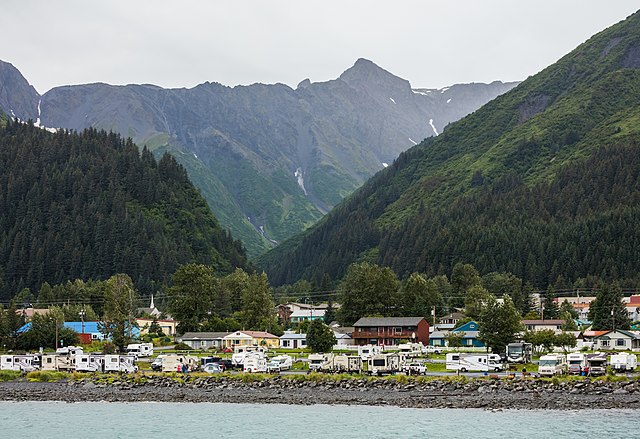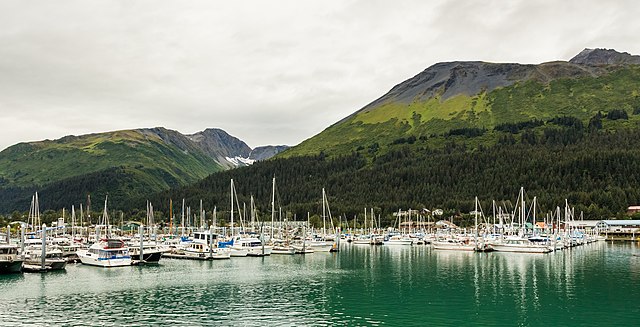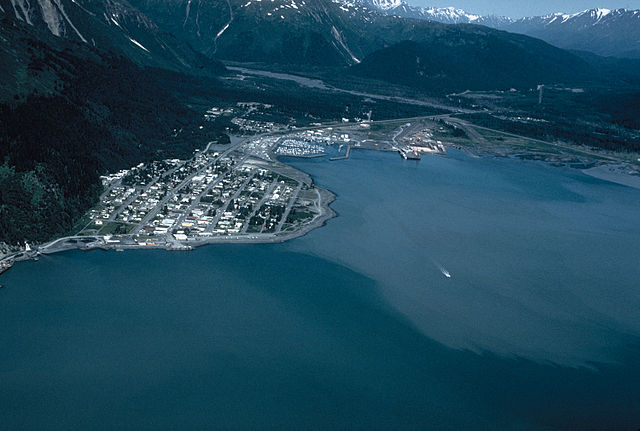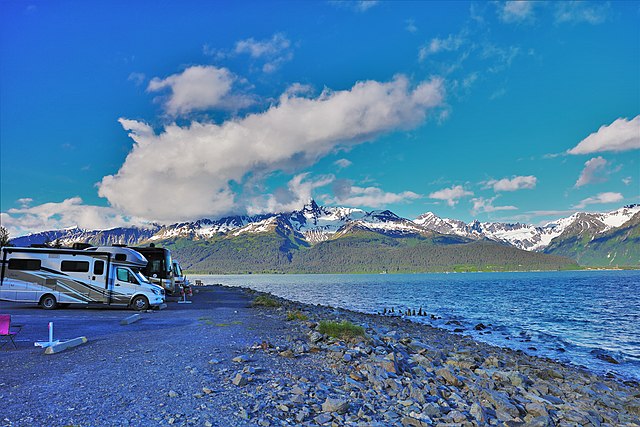Welcome to Seward, Alaska – a breathtaking coastal town that serves as your gateway to some of the most spectacular wilderness experiences on Earth. Nestled between towering mountains and the pristine waters of Resurrection Bay, this charming community of just over 2,700 residents punches well above its weight when it comes to adventure opportunities.
Have you ever wondered what it feels like to stand face-to-face with a massive glacier or watch humpback whales breach just yards from your boat? Seward makes these dreams reality. This isn’t just another tourist destination; it’s a place where nature puts on a daily show that’ll leave you speechless.
Why Seward Should Be on Your Alaska Bucket List
Seward isn’t your typical small town. It’s the kind of place where you might see a bald eagle soaring overhead while you’re grabbing your morning coffee, or spot a sea otter playing in the harbor while you’re walking to dinner. The town serves as the southern terminus of the Alaska Railroad and the northern gateway to Kenai Fjords National Park, making it a crucial hub for Alaska adventures.
What sets Seward apart is its incredible accessibility to world-class natural wonders. You don’t need to be an experienced mountaineer or wilderness expert to experience Alaska’s raw beauty here. Whether you’re a family with young kids or seasoned adventurers, Seward offers experiences that’ll create memories lasting a lifetime.
The town’s maritime heritage runs deep, and you’ll feel it everywhere you go. From the bustling harbor filled with fishing boats and tour vessels to the salty sea breeze that carries stories of generations of fishermen and explorers, Seward embodies the authentic Alaska experience that many visitors are seeking.
Getting to Seward: Your Gateway to Adventure
Reaching Seward is part of the adventure itself. Most visitors arrive via the scenic Seward Highway, consistently ranked as one of America’s most beautiful drives. This 127-mile stretch from Anchorage winds through Chugach National Forest, offering stunning views of mountains, glaciers, and Turnagain Arm.
The Alaska Railroad also connects Anchorage to Seward, providing a comfortable and scenic alternative to driving. The train journey takes about four hours and offers panoramic views through large windows and outdoor viewing platforms. Many travelers find this train ride to be a highlight of their Alaska trip.
For those flying into Alaska, Anchorage serves as the primary entry point, with Seward being an easy two-and-a-half-hour drive south. The town itself is compact and walkable, with most attractions, restaurants, and accommodations within easy reach of the harbor area.
Top Natural Attractions in Seward

Kenai Fjords National Park: A Wilderness Wonderland
Kenai Fjords National Park is undoubtedly Seward’s crown jewel. This 669,984-acre park protects some of Alaska’s most pristine wilderness, including the massive Harding Icefield and numerous tidewater glaciers. The park offers visitors a chance to witness the raw power of nature as glaciers calve into the sea, creating thunderous sounds that echo across the fjords.
The park’s marine environment supports an incredible diversity of wildlife. Stellar sea lions haul out on rocky outcrops, while harbor seals bob in the waves. The deeper waters attract humpback whales, orcas, and fin whales, making every boat trip an potential wildlife spectacular.
What makes Kenai Fjords truly special is its accessibility. Unlike many national parks where you need extensive backcountry experience, you can experience much of this park’s beauty through day tours departing directly from Seward’s harbor. These tours range from half-day trips to full-day expeditions, each offering unique perspectives on this glacial wonderland.
Exit Glacier: Touch Ancient Ice
Exit Glacier provides one of the few opportunities in Alaska to walk right up to a glacier. This accessible glacier, part of the massive Harding Icefield, offers visitors a chance to witness climate change in action. The glacier has been retreating for decades, and markers along the trail show where the ice edge was in previous years.
The walk to Exit Glacier is relatively easy, making it perfect for families. The trail is well-maintained and offers multiple viewpoints as you approach the glacier. The closer you get, the more you’ll feel the glacier’s presence – the air becomes noticeably cooler, and you might hear the occasional crack or groan as the ice shifts.
For those seeking more adventure, the Harding Icefield Trail continues beyond Exit Glacier, offering a challenging hike to spectacular views of the icefield that feeds multiple glaciers. This trail isn’t for everyone, but those who complete it are rewarded with views that few people on Earth ever see.
Resurrection Bay: Marine Paradise
Resurrection Bay serves as Seward’s front yard, and what a front yard it is! This deep, protected bay provides calm waters perfect for kayaking, wildlife watching, and fishing. The bay’s name comes from Russian explorers who entered it on Resurrection Sunday, and it’s been inspiring visitors ever since.
The bay’s protected waters make it an ideal nursery for marine life. Harbor seals are common residents, often curious about kayakers and boaters. The bay also serves as a feeding ground for various whale species, particularly during summer months when salmon runs attract these magnificent creatures.
From the harbor, you can see Resurrection Bay stretch toward the Gulf of Alaska, framed by mountains on both sides. The contrast between the deep blue water and snow-capped peaks creates postcard-perfect views that photographers dream about.
Wildlife Watching Opportunities
Whale Watching Tours
Seward’s location at the mouth of Resurrection Bay makes it one of Alaska’s premier whale watching destinations. Humpback whales are the stars of the show, with their acrobatic displays and haunting songs. These 40-foot giants aren’t shy about putting on a performance, often breaching, tail slapping, and bubble net feeding right in front of tour boats.
Orca pods also frequent these waters, and there’s nothing quite like seeing these apex predators in their natural habitat. The resident orcas have learned to follow fishing boats, hoping to snag an easy meal, while transient pods hunt for marine mammals throughout the bay and fjords.
Tours typically run from May through September, with peak whale activity occurring during summer months. Many operators offer guaranteed sightings or your money back, though refunds are rarely needed given the abundance of marine life in these waters.
Sea Otter and Seal Spotting
Sea otters are arguably the most entertaining marine mammals you’ll encounter in Seward. These playful creatures spend their days floating on their backs, using rocks to crack open shellfish, and engaging in what can only be described as aquatic acrobatics. They’re often found in kelp beds around Resurrection Bay, where they wrap themselves in kelp to avoid drifting while they sleep.
Harbor seals are equally charming, with their dog-like faces and curious nature. They’re often seen hauled out on rocks or ice floes, but they’re equally comfortable in the water, where they’re surprisingly agile. Steller sea lions, much larger than harbor seals, also frequent the area and can be quite impressive when encountered in groups.
The best part about spotting these marine mammals is that you don’t need to go far from shore. Many can be seen right from the harbor or during short boat trips around Resurrection Bay.
Bird Watching at the Alaska SeaLife Center
The Alaska SeaLife Center isn’t just an aquarium; it’s a research facility and rehabilitation center that offers incredible bird watching opportunities. The center cares for injured and orphaned seabirds, giving visitors up-close encounters with species like puffins, murres, and cormorants.
Outside the center, Seward’s location along the Pacific Flyway makes it a bird watcher’s paradise. Bald eagles are common year-round, often seen perched on harbor pilings or soaring overhead. During migration seasons, the variety of species is truly impressive.
The rocky shores around Resurrection Bay provide nesting habitat for numerous seabird species. Boat tours often include stops at bird rookeries where you can observe thousands of birds going about their daily lives on clifftop colonies.
Adventure Activities for Thrill Seekers
Kayaking Through Pristine Waters
Sea kayaking in Resurrection Bay offers an intimate way to experience Alaska’s marine environment. The bay’s protected waters make it suitable for paddlers of all skill levels, from complete beginners to experienced kayakers seeking multi-day adventures.
Half-day tours are perfect for first-timers, typically including basic instruction and a paddle around the harbor area. These trips often include wildlife sightings and give you a unique perspective on Seward from the water. The silence of paddling allows you to hear sounds you’d miss on a motorized boat – the splash of a seal diving, the blow of a whale surfacing, or the cry of seabirds overhead.
For more experienced paddlers, multi-day camping trips into Kenai Fjords National Park offer true wilderness experiences. These expeditions might include paddling to remote beaches, camping under the midnight sun, and waking up to the sound of glaciers calving in the distance.
Hiking Trails for Every Skill Level

Seward’s location between mountains and sea provides hiking opportunities for every ability level. The town serves as a trailhead for everything from easy nature walks to challenging mountain ascents.
Mount Marathon Trail
The Mount Marathon Trail is Seward’s most famous hike, known primarily for the annual Mount Marathon Race held every Fourth of July. This challenging trail gains 3,000 feet of elevation in just over three miles, leading to spectacular views of Resurrection Bay and the surrounding mountains.
Don’t let the race intimidate you – the trail can be hiked at your own pace and offers multiple stopping points with great views. The trail is steep and can be muddy, so proper footwear is essential. The reward at the top includes 360-degree views that on clear days extend all the way to the Gulf of Alaska.
The descent can be tricky, as racers often slide down loose scree slopes. Hikers should take their time coming down and consider using the more gradual Jewell Gardens Trail for the descent.
Harding Icefield Trail
For serious hikers, the Harding Icefield Trail offers one of Alaska’s most rewarding day hikes. This challenging 8.2-mile round-trip trail starts at Exit Glacier and climbs 3,500 feet to the edge of the Harding Icefield.
The trail is well-marked but demanding, typically taking 6-8 hours to complete. The first portion follows the Exit Glacier trail before branching off into more challenging terrain. As you climb, you’ll pass through different ecological zones, from coastal forest to alpine tundra.
The payoff comes at the top, where you’ll stand on the edge of a 700-square-mile icefield that feeds over 30 glaciers. The view is otherworldly – a white expanse stretching to the horizon, broken only by mountain peaks called nunataks that poke through the ice.
Fishing Charters and Opportunities
Seward’s location makes it one of Alaska’s premier fishing destinations. The deep waters of Resurrection Bay and the Gulf of Alaska support healthy populations of salmon, halibut, rockfish, and other species that attract anglers from around the world.
Halibut fishing is particularly popular, with these flatfish growing to enormous sizes in Alaska waters. Landing a 100-pound halibut is considered a rite of passage for many visiting anglers. Charter operators provide all necessary equipment and expertise, making it accessible even for novice fishermen.
Salmon fishing varies by season, with different species running at different times. Silver salmon (coho) provide exciting fights and excellent eating, while king salmon (chinook) are prized for their size and strength. Many charters offer combination trips that include both fishing and wildlife viewing.
Cultural and Educational Experiences

Alaska SeaLife Center
The Alaska SeaLife Center stands as Alaska’s premier marine science facility and public aquarium. This world-class facility combines research, rehabilitation, and education in a way that makes marine science accessible and exciting for visitors of all ages.
The center’s exhibits feature Alaska’s marine ecosystems, from the intertidal zone to the deep ocean. Touch tanks allow hands-on interaction with sea stars, anemones, and other tide pool creatures. The large tanks housing seals, sea lions, and seabirds provide opportunities to observe these animals’ natural behaviors up close.
What sets the SeaLife Center apart is its active research and rehabilitation programs. Visitors might see marine mammal pups being bottle-fed or seabirds recovering from oil spills. This real-world conservation work gives the center an authenticity that pure entertainment facilities can’t match.
Seward Museum
The Seward Museum provides insight into the town’s rich history, from its founding as a railroad terminus to its role in Alaska’s development. The museum’s collection includes artifacts from the area’s Native Alaskan inhabitants, Russian exploration period, and American territorial days.
One of the museum’s most compelling exhibits covers the 1964 Good Friday Earthquake, which devastated Seward and much of south-central Alaska. The exhibit includes dramatic before-and-after photos showing how the earthquake and resulting tsunami reshaped the town’s waterfront.
The museum also celebrates Seward’s maritime heritage, with displays on commercial fishing, the Alaska Railroad, and the town’s role as a gateway to Interior Alaska during the gold rush era.
Native Alaskan Heritage
The Seward area has been home to Native Alaskan peoples for thousands of years. The Alutiiq people, also known as Sugpiaq, were the primary inhabitants of this coastal region, developing a sophisticated culture adapted to life in this challenging environment.
Evidence of this long occupation can be found throughout the region, from archaeological sites to place names that reflect Native languages. Many local tour operators and cultural centers provide opportunities to learn about traditional ways of life, including subsistence practices, traditional crafts, and spiritual beliefs.
Understanding this heritage adds depth to any Seward visit, helping visitors appreciate that this landscape has supported human life for millennia before becoming a tourist destination.
Seasonal Activities in Seward
Summer Adventures (June-August)
Summer represents peak season in Seward, and for good reason. Long daylight hours – up to 19 hours in June – provide plenty of time for activities. Temperatures are mild, typically ranging from the 50s to 60s Fahrenheit, perfect for outdoor activities.
This is prime time for wildlife viewing, with whales, seabirds, and marine mammals most active. Boat tours run regularly, hiking trails are snow-free, and camping is comfortable. The famous Mount Marathon Race occurs on July 4th, bringing thousands of visitors to town for this unique sporting event.
Summer also offers the best weather for sea kayaking, with calmer waters and longer days providing ideal paddling conditions. Many multi-day tours and expeditions are only available during summer months.
Winter Magic (December-February)
Winter in Seward offers a completely different but equally magical experience. Snow transforms the landscape into a winter wonderland, while the possibility of viewing northern lights adds another dimension to the visit.
Winter activities include dog sledding, cross-country skiing, and snowshoeing. The Exit Glacier area becomes a winter recreation destination, with groomed trails for various snow sports. Ice climbing opportunities exist for those with proper equipment and experience.
Wildlife viewing continues year-round, though the focus shifts to resident species. Bald eagles remain active, and marine mammals can still be observed, though boat tours are limited by weather and daylight hours.
Shoulder Season Gems (Spring & Fall)
Spring (April-May) and fall (September-October) offer unique advantages for visitors seeking fewer crowds and different experiences. Spring brings longer days and the excitement of wildlife returning to active feeding after winter. Bear viewing can be excellent during spring months.
Fall offers spectacular colors as deciduous plants change, creating beautiful contrasts with evergreen forests and snow-capped peaks. Wildlife activity remains high as animals prepare for winter, and weather can still be quite pleasant for outdoor activities.
These shoulder seasons often provide better deals on accommodations and tours, making them attractive for budget-conscious travelers who don’t mind slightly cooler weather and shorter days.
Where to Stay in Seward
Seward offers accommodations ranging from luxury resorts to budget-friendly hostels, ensuring options for every traveler and budget. Most lodging is concentrated near the harbor, putting you within walking distance of restaurants, shops, and tour operators.
The historic Seward Windsong Lodge offers upscale accommodations in a beautiful setting near Exit Glacier. For those seeking luxury, several bed and breakfasts provide personalized service and local insights from knowledgeable hosts.
Budget travelers can choose from several hostels and camping options. The city operates campgrounds with varying amenities, while nearby state and national park campgrounds offer more rustic experiences for those seeking to immerse themselves in nature.
Dining and Local Cuisine
Seward’s restaurants reflect both its maritime heritage and its role as a tourist destination. Fresh seafood dominates many menus, with locally caught salmon, halibut, and crab featured prominently. Several restaurants are located right on the harbor, offering waterfront dining with views of fishing boats and wildlife.
The Cookery stands out for its fresh, locally sourced ingredients and creative preparations of Alaska seafood. Chinooks Waterfront Restaurant offers classic preparations of local catches in a casual atmosphere with harbor views.
For those seeking quick meals between activities, several cafes and casual dining spots provide hearty breakfasts and satisfying lunches. Many establishments cater to outdoor enthusiasts, offering early opening hours and grab-and-go options for those heading out on day-long adventures.
Planning Your Visit: Tips and Recommendations

Planning a Seward visit requires consideration of your interests, fitness level, and time constraints. Most visitors spend 2-4 days in the area, though a week allows for more in-depth exploration and relaxation between activities.
Book accommodations and major tours well in advance, especially for summer visits. Popular activities like glacier cruises and fishing charters can sell out during peak season. Consider travel insurance, as weather can occasionally disrupt plans.
Pack layers and waterproof gear regardless of season. Weather can change quickly, and maritime conditions mean precipitation is always possible. Good walking shoes are essential, even if you’re not planning serious hiking.
Consider purchasing a National Parks Pass if you’re visiting multiple parks during your Alaska trip. The pass pays for itself quickly and supports park conservation efforts.
Conclusion
Seward, Alaska, offers an unparalleled combination of accessibility and wilderness adventure that’s hard to find anywhere else in the world. Whether you’re watching humpback whales breach in Resurrection Bay, hiking to the edge of an ancient icefield, or simply enjoying fresh seafood while seabirds call overhead, Seward provides experiences that connect you with Alaska’s wild heart.
This charming coastal town serves as more than just a gateway to adventure – it’s a destination in its own right, where every day brings possibilities for discovery and wonder. From the moment you arrive until your reluctant departure, Seward will challenge your expectations and create memories that last a lifetime.
The magic of Seward lies not just in its spectacular scenery or abundant wildlife, but in how it makes the extraordinary feel accessible. You don’t need to be an expert mountaineer or experienced wilderness traveler to experience some of Earth’s most pristine and powerful natural phenomena. You just need curiosity, a sense of adventure, and the willingness to step outside your comfort zone.
Start planning your Seward adventure today – this remarkable corner of Alaska is waiting to show you wonders you never imagined possible.
Frequently Asked Questions
1. What is the best time of year to visit Seward, Alaska?
The best time to visit Seward depends on your interests. Summer (June-August) offers the warmest weather, longest days, and peak wildlife activity, making it ideal for boat tours and hiking. However, spring (April-May) and fall (September-October) provide fewer crowds, potentially better prices, and unique seasonal experiences like fall colors or spring wildlife activity.
2. How many days should I spend in Seward?
Most visitors find 2-4 days sufficient to experience Seward’s main attractions, including a glacier cruise, Exit Glacier visit, and some hiking or wildlife viewing. However, if you’re interested in fishing, kayaking, or more extensive hiking, a week allows for a more relaxed pace and deeper exploration of the area.
3. Do I need a car to get around Seward?
No, you don’t need a car to enjoy Seward. The town is compact and walkable, with most attractions, restaurants, and accommodations within easy walking distance of the harbor. However, a car is helpful for reaching Exit Glacier independently or exploring hiking trails outside town.
4. What should I pack for a trip to Seward?
Pack layers and waterproof clothing regardless of season, as weather can change quickly. Essential items include waterproof jacket and pants, warm layers, comfortable walking shoes, sun protection, and a daypack for activities. Even in summer, temperatures can be cool, especially on the water.
5. Are Seward’s activities suitable for families with children?
Yes, many of Seward’s activities are family-friendly. The Alaska SeaLife Center, Exit Glacier walks, harbor area exploration, and shorter boat tours are all suitable for children. Many tour operators offer family-specific trips and have age-appropriate safety equipment. However, activities like the Mount Marathon hike or extended sea kayaking trips may be better suited for older children and teens.

